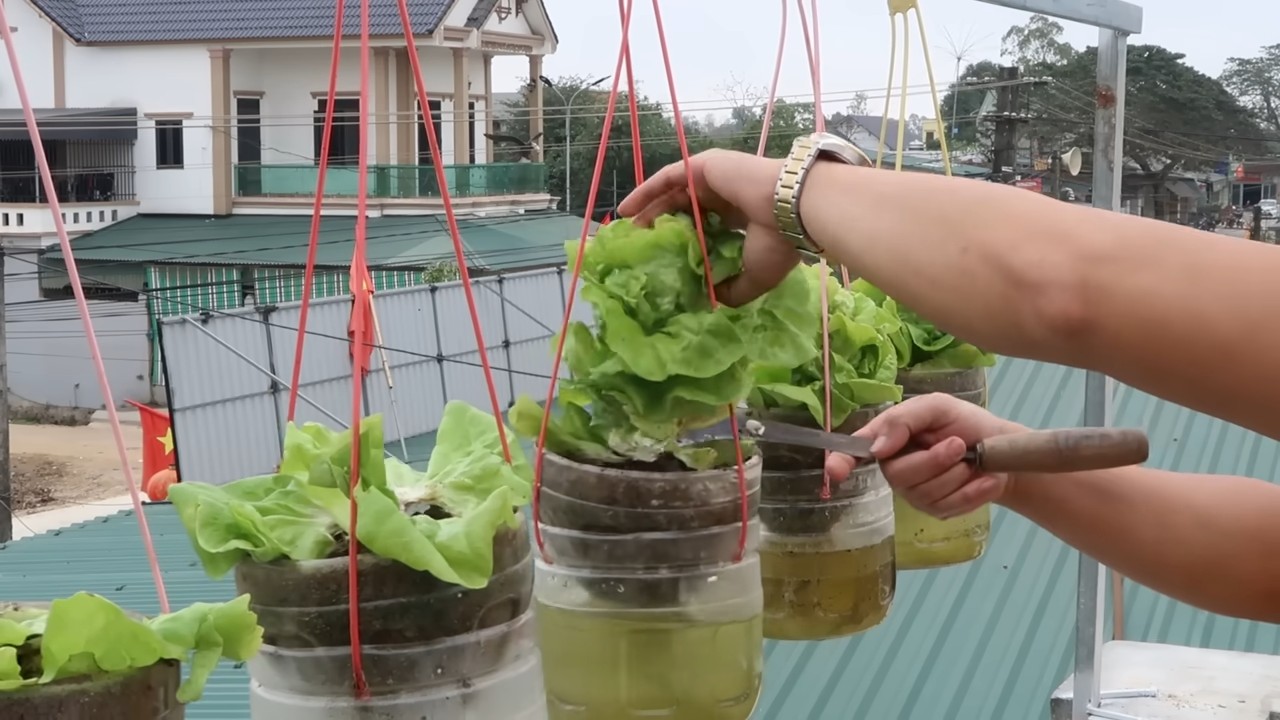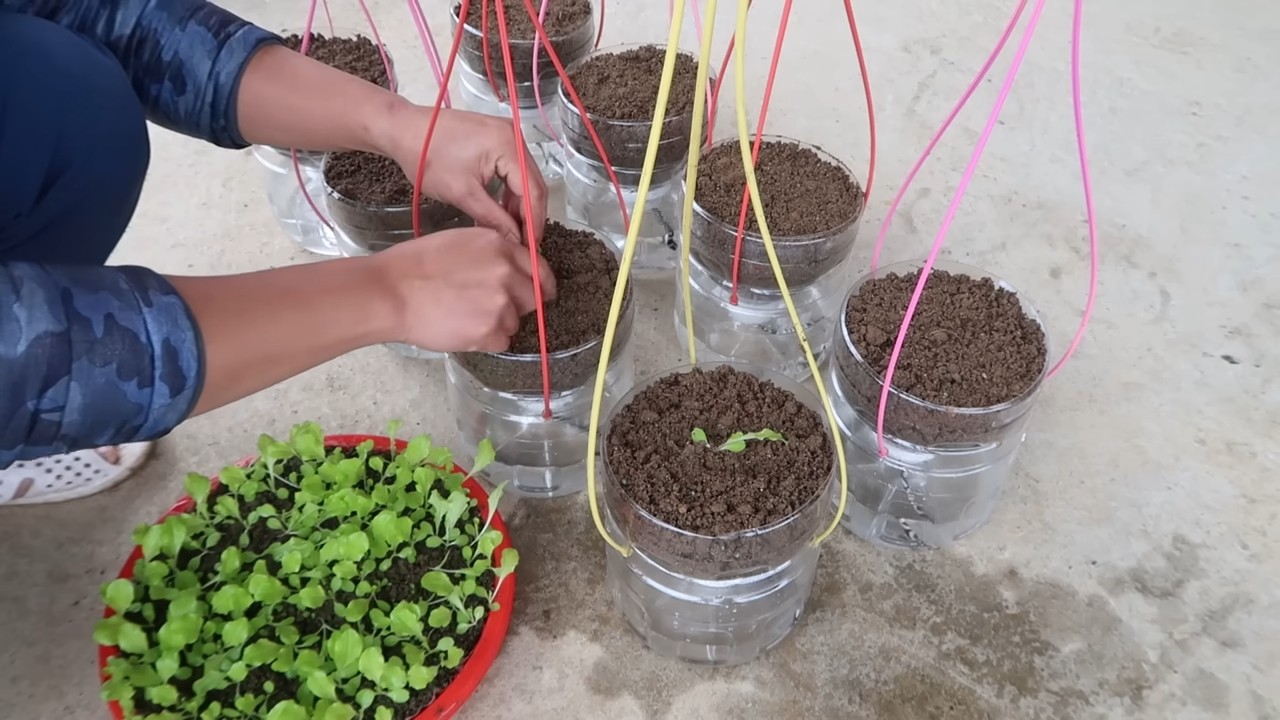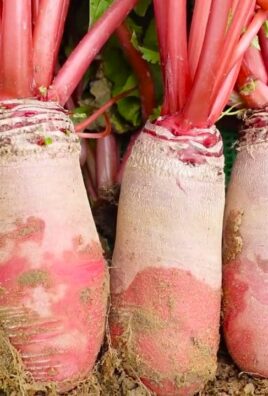Hanging bottle lettuce garden: Imagine stepping outside your door and plucking fresh, crisp lettuce leaves for your salad, all grown in a charming, space-saving garden you created yourself! Sounds dreamy, right? Well, it’s totally achievable with a DIY hanging bottle lettuce garden! For centuries, humans have cultivated gardens, from the elaborate hanging gardens of Babylon to the humble kitchen gardens of medieval Europe. The desire to nurture and grow our own food is deeply ingrained in us.
But let’s face it, not everyone has acres of land or even a traditional garden bed. That’s where this ingenious DIY project comes in. A hanging bottle lettuce garden is the perfect solution for apartment dwellers, balcony gardeners, or anyone looking to add a touch of green to their lives without taking up precious ground space. Plus, it’s a fantastic way to recycle those plastic bottles that might otherwise end up in a landfill.
This article will guide you through creating your own thriving hanging bottle lettuce garden, step-by-step. I’ll share my favorite tips and tricks for choosing the right bottles, preparing the soil, and keeping your lettuce happy and healthy. Get ready to transform your space into a verdant oasis and enjoy the satisfaction of harvesting your own delicious, homegrown lettuce!

DIY Hängender Flaschen-Salatgarten: Dein eigener grüner Daumen für die Wand
Hallo liebe Gartenfreunde! Habt ihr Lust auf frischen Salat direkt von der Wand? Dann seid ihr hier genau richtig! Ich zeige euch, wie ihr aus einfachen Plastikflaschen einen vertikalen Salatgarten zaubern könnt. Das ist nicht nur super platzsparend, sondern auch ein echter Hingucker. Und das Beste: Ihr könnt euren Salat jederzeit ernten und wisst genau, wo er herkommt. Los geht’s!
Was du brauchst: Die Materialliste
Bevor wir loslegen, hier eine Liste mit allen Materialien, die du für deinen hängenden Flaschen-Salatgarten benötigst:
* Plastikflaschen: Am besten PET-Flaschen (z.B. von Wasser oder Saft). Die Anzahl hängt davon ab, wie groß dein Garten werden soll. Ich empfehle, mit 5-6 Flaschen zu starten. Achte darauf, dass sie sauber und trocken sind.
* Schere oder Cuttermesser: Zum Zuschneiden der Flaschen. Sei bitte vorsichtig!
* Bohrmaschine oder Nagel und Hammer: Um Löcher für die Aufhängung und die Drainage zu bohren.
* Starkes Seil oder Draht: Zum Aufhängen der Flaschen. Denk daran, dass das Seil das Gewicht der befüllten Flaschen tragen muss.
* Erde: Am besten Blumenerde oder spezielle Gemüseerde.
* Salatsamen oder Jungpflanzen: Je nachdem, wie schnell du ernten möchtest. Ich persönlich mag es, mit Jungpflanzen zu starten, da es schneller geht.
* Kleine Steine oder Tonscherben: Für die Drainage am Boden der Flaschen.
* Gießkanne oder Sprühflasche: Zum Bewässern deiner Salatpflanzen.
* Handschuhe: Um deine Hände sauber zu halten.
* Optional: Sprühfarbe, um die Flaschen zu bemalen und den Garten noch individueller zu gestalten.
Die Vorbereitung: Flaschen zuschneiden und vorbereiten
Dieser Schritt ist entscheidend für den Erfolg deines vertikalen Gartens. Nimm dir Zeit und arbeite sorgfältig.
1. Flaschen reinigen: Zuerst musst du alle Plastikflaschen gründlich reinigen. Entferne Etiketten und Klebereste. Spüle die Flaschen mit warmem Wasser und Spülmittel aus und lasse sie gut trocknen.
2. Flaschen zuschneiden: Jetzt kommt der knifflige Teil. Du musst die Flaschen so zuschneiden, dass sie als Pflanzgefäße dienen können. Ich empfehle, die Flaschen horizontal zu halbieren oder etwas mehr als die Hälfte abzuschneiden. Die obere Hälfte wird dann umgedreht in die untere Hälfte gesteckt, um einen kleinen Topf zu bilden.
* Markiere die Schnittlinie: Verwende einen Stift, um eine gerade Linie um die Flasche zu ziehen, wo du sie schneiden möchtest.
* Schneide die Flasche: Mit der Schere oder dem Cuttermesser schneidest du nun entlang der markierten Linie. Sei dabei sehr vorsichtig, um dich nicht zu verletzen.
* Glätte die Kanten: Die Schnittkanten können scharf sein. Glätte sie vorsichtig mit Schleifpapier oder einem Feuerzeug (nur kurz und vorsichtig!).
3. Drainagelöcher bohren: Damit das Wasser gut ablaufen kann und sich keine Staunässe bildet, musst du Drainagelöcher in den Boden der Flaschen bohren.
* Bohre 3-4 Löcher: Verwende eine Bohrmaschine oder einen Nagel und Hammer, um 3-4 kleine Löcher in den Boden jeder Flasche zu bohren.
4. Aufhängungslöcher bohren: Jetzt musst du Löcher bohren, um die Flaschen später aufhängen zu können.
* Bohre 2 Löcher: Bohre zwei Löcher an den Seiten jeder Flasche, nahe am oberen Rand. Die Löcher sollten gegenüberliegen und groß genug sein, um das Seil oder den Draht hindurchzufädeln.
5. Optional: Flaschen bemalen: Wenn du möchtest, kannst du die Flaschen jetzt mit Sprühfarbe bemalen. Das macht deinen Garten noch individueller und schützt die Pflanzen vor zu viel Sonneneinstrahlung. Lass die Farbe gut trocknen, bevor du mit dem nächsten Schritt fortfährst.
Der Aufbau: Flaschen befüllen und aufhängen
Jetzt kommt der spaßige Teil: Wir befüllen die Flaschen mit Erde und bepflanzen sie mit Salat.
1. Drainage einfüllen: Gib eine Schicht kleine Steine oder Tonscherben auf den Boden jeder Flasche. Das sorgt für eine gute Drainage und verhindert Staunässe.
2. Erde einfüllen: Fülle die Flaschen mit Erde. Lass oben noch etwas Platz, damit du die Pflanzen später gut gießen kannst.
3. Salat pflanzen: Setze die Salatsamen oder Jungpflanzen in die Erde. Achte darauf, dass die Wurzeln gut bedeckt sind.
4. Flaschen aufhängen: Fädle das Seil oder den Draht durch die Aufhängungslöcher jeder Flasche. Verbinde die Flaschen miteinander, so dass sie eine vertikale Kette bilden. Achte darauf, dass die Abstände zwischen den Flaschen nicht zu groß sind, damit die Pflanzen genügend Licht bekommen.
5. Garten aufhängen: Hänge deinen fertigen Flaschen-Salatgarten an einem sonnigen Ort auf. Achte darauf, dass die Aufhängung stabil ist und das Gewicht der befüllten Flaschen tragen kann.
Die Pflege: Salat gießen und ernten
Damit dein Salat gut wächst und gedeiht, ist die richtige Pflege wichtig.
1. Richtig gießen: Gieße deinen Salat regelmäßig, aber nicht zu viel. Die Erde sollte immer leicht feucht sein. Vermeide Staunässe, da dies zu Wurzelfäule führen kann. Am besten gießt du morgens oder abends, wenn die Sonne nicht so stark scheint.
2. Düngen: Dünge deinen Salat regelmäßig mit einem organischen Dünger. Das sorgt für ein gesundes Wachstum und eine reiche Ernte.
3. Schädlinge bekämpfen: Kontrolliere deine Salatpflanzen regelmäßig auf Schädlinge wie Schnecken oder Blattläuse. Bei Bedarf kannst du natürliche Schädlingsbekämpfungsmittel einsetzen.
4. Ernten: Sobald der Salat groß genug ist, kannst du ihn ernten. Schneide die Blätter einfach mit einem Messer ab. Der Salat wächst dann wieder nach.
Zusätzliche Tipps und Tricks
* Verschiedene Salatsorten: Probiere verschiedene Salatsorten aus, um deinen Garten abwechslungsreicher zu gestalten.
* Kräuter: Du kannst auch Kräuter wie Petersilie, Schnittlauch oder Basilikum in deinen Flaschen-Salatgarten pflanzen.
* Sonnenschutz: Wenn dein Garten in der prallen Sonne steht, kannst du ihn mit einem Sonnensegel oder einer Plane beschatten.
* Winterfest machen: Im Winter solltest du deinen Garten an einen geschützten Ort stellen oder ihn mit Vlies abdecken, um die Pflanzen vor Frost zu schützen.
* Upcycling: Verwende alte T-Shirts oder Stoffreste, um die Flaschen zu umwickeln und den Garten noch bunter zu gestalten.
* Beschriftung: Beschrifte die Flaschen mit den Namen der Salatsorten, damit du den Überblick behältst.
Ich hoffe, diese Anleitung hilft dir dabei, deinen eigenen hängenden Flaschen-Salatgarten zu gestalten. Viel Spaß beim Gärtnern und guten Appetit!

Conclusion
So, there you have it! Creating your own hanging bottle lettuce garden isn’t just a fun project; it’s a sustainable, space-saving, and incredibly rewarding way to enjoy fresh, delicious lettuce right at your fingertips. We’ve walked you through the simple steps, highlighting the benefits and addressing potential challenges. But why is this DIY trick a must-try?
First and foremost, it’s about freshness. Imagine stepping outside your door and harvesting crisp, vibrant lettuce leaves moments before adding them to your salad or sandwich. The taste difference compared to store-bought lettuce is undeniable. Plus, you control the growing environment, ensuring your lettuce is free from harmful pesticides and herbicides.
Secondly, it’s about sustainability. Repurposing plastic bottles reduces waste and gives them a new lease on life. You’re actively participating in a circular economy, minimizing your environmental impact while enjoying the fruits (or rather, the leaves) of your labor.
Thirdly, it’s about space. Whether you have a sprawling backyard or a tiny balcony, a hanging bottle lettuce garden can thrive. Vertical gardening maximizes your growing potential, allowing you to cultivate a surprising amount of produce in a limited area.
But the beauty of this project lies in its adaptability. Feel free to experiment with different types of lettuce. Romaine, butterhead, and loose-leaf varieties all thrive in hanging bottle gardens. You can also add companion plants like herbs (basil, oregano, thyme) to deter pests and enhance the flavor of your lettuce. Consider painting the bottles to add a splash of color to your outdoor space or using different colored bottles to create a visually appealing display. You can even add a simple drip irrigation system for easier watering.
Don’t be afraid to get creative and personalize your hanging bottle lettuce garden to suit your style and needs.
We understand that embarking on a new DIY project can be daunting, but we assure you that this one is incredibly beginner-friendly. The satisfaction of watching your lettuce seedlings sprout and flourish is truly unmatched. And the taste of that first homegrown salad? Absolutely divine.
So, what are you waiting for? Gather your supplies, follow our simple instructions, and get ready to experience the joy of growing your own lettuce. We’re confident that you’ll be amazed by the results.
We encourage you to try this DIY trick and share your experience with us! Post photos of your hanging bottle lettuce garden on social media using #HangingBottleLettuceGarden and tag us. We can’t wait to see your creations and hear about your successes (and any challenges you might encounter). Let’s build a community of passionate gardeners who are committed to sustainable and delicious living. Happy gardening!
Frequently Asked Questions (FAQ)
What kind of plastic bottles are best for a hanging bottle lettuce garden?
Ideally, you should use food-grade plastic bottles, such as those that previously contained water, juice, or soda. Avoid using bottles that held harsh chemicals or cleaning products, as these could contaminate your lettuce. PET (polyethylene terephthalate) bottles are a common and safe choice. Make sure to thoroughly wash and rinse the bottles before using them. The size of the bottle will depend on the variety of lettuce you plan to grow. Larger bottles are better for larger lettuce types.
What kind of soil should I use for my hanging bottle lettuce garden?
A well-draining potting mix is essential for healthy lettuce growth. Avoid using garden soil, as it can become compacted in containers and hinder drainage. Look for a potting mix that contains ingredients like peat moss, perlite, and vermiculite. You can also add compost to enrich the soil and provide essential nutrients. A slightly acidic to neutral pH (around 6.0 to 7.0) is ideal for lettuce.
How often should I water my hanging bottle lettuce garden?
The frequency of watering will depend on the weather conditions, the type of potting mix you’re using, and the size of your bottles. Generally, you should water your lettuce when the top inch of soil feels dry to the touch. Avoid overwatering, as this can lead to root rot. During hot, dry weather, you may need to water daily. In cooler, wetter weather, you may only need to water every few days. Ensure the bottles have adequate drainage holes to prevent waterlogging.
How much sunlight does my hanging bottle lettuce garden need?
Lettuce thrives in full sun to partial shade. Aim for at least 4-6 hours of direct sunlight per day. If you live in a hot climate, providing some afternoon shade can help prevent the lettuce from bolting (going to seed prematurely). Observe your lettuce plants closely and adjust their location as needed to ensure they’re getting the right amount of sunlight.
How do I fertilize my hanging bottle lettuce garden?
Lettuce is a relatively light feeder, but it still benefits from regular fertilization. You can use a balanced liquid fertilizer diluted to half strength every 2-3 weeks. Alternatively, you can incorporate slow-release fertilizer granules into the potting mix at planting time. Avoid over-fertilizing, as this can lead to leggy growth and bitter-tasting lettuce.
How do I prevent pests and diseases in my hanging bottle lettuce garden?
Regularly inspect your lettuce plants for signs of pests or diseases. Common lettuce pests include aphids, slugs, and snails. You can control aphids with a strong spray of water or by introducing beneficial insects like ladybugs. Slugs and snails can be handpicked or trapped using beer traps. To prevent fungal diseases, ensure good air circulation around your plants and avoid overwatering. You can also use organic fungicides if necessary.
How long does it take for lettuce to grow in a hanging bottle garden?
The time it takes for lettuce to mature will depend on the variety you’re growing and the growing conditions. Generally, you can expect to harvest your first lettuce leaves in about 30-45 days from planting. Loose-leaf varieties can be harvested continuously by picking outer leaves as needed. Head lettuce varieties will take longer to mature, typically around 60-80 days.
Can I grow other plants besides lettuce in my hanging bottle garden?
Yes, you can grow other plants in your hanging bottle garden, especially herbs. Herbs like basil, oregano, thyme, and parsley are great companions for lettuce and can help deter pests. You can also grow small flowering plants like marigolds or nasturtiums to attract pollinators and add beauty to your garden. Just make sure to choose plants that have similar growing requirements as lettuce.
How do I harvest lettuce from my hanging bottle garden?
For loose-leaf lettuce varieties, simply snip off the outer leaves as needed, leaving the inner leaves to continue growing. For head lettuce varieties, wait until the head is firm and well-formed before harvesting. Cut the head at the base of the plant with a sharp knife.
What do I do with my hanging bottle lettuce garden in the winter?
In colder climates, you may need to bring your hanging bottle lettuce garden indoors during the winter months. Place it near a sunny window or under grow lights. You can also use a cold frame or greenhouse to extend the growing season. If you live in a mild climate, you may be able to leave your lettuce garden outdoors year-round, but be sure to protect it from frost.




Leave a Comment